HRM4002 People in Organisations: A Case Study Report on Johnsons
VerifiedAdded on 2023/06/04
|9
|3667
|170
Case Study
AI Summary
This case study examines Johnsons of Whixley (JW), a large industrial nursery, focusing on leadership roles, organisational structure, and culture in promoting successful transformation. It addresses how to build a competent team through engagement and incentives. The analysis covers the importance of leadership in inspiring innovation and guiding employees through organisational changes. It also discusses how organisational structure and culture support transformational change by encouraging and rewarding staff. The case study further explores strategies for motivating teams to work effectively, including incentives, rewards, and team-based learning, highlighting the importance of intrinsic motivation and employee empowerment. Concluding the importance of good leadership to ensure the success of any transformation effort.
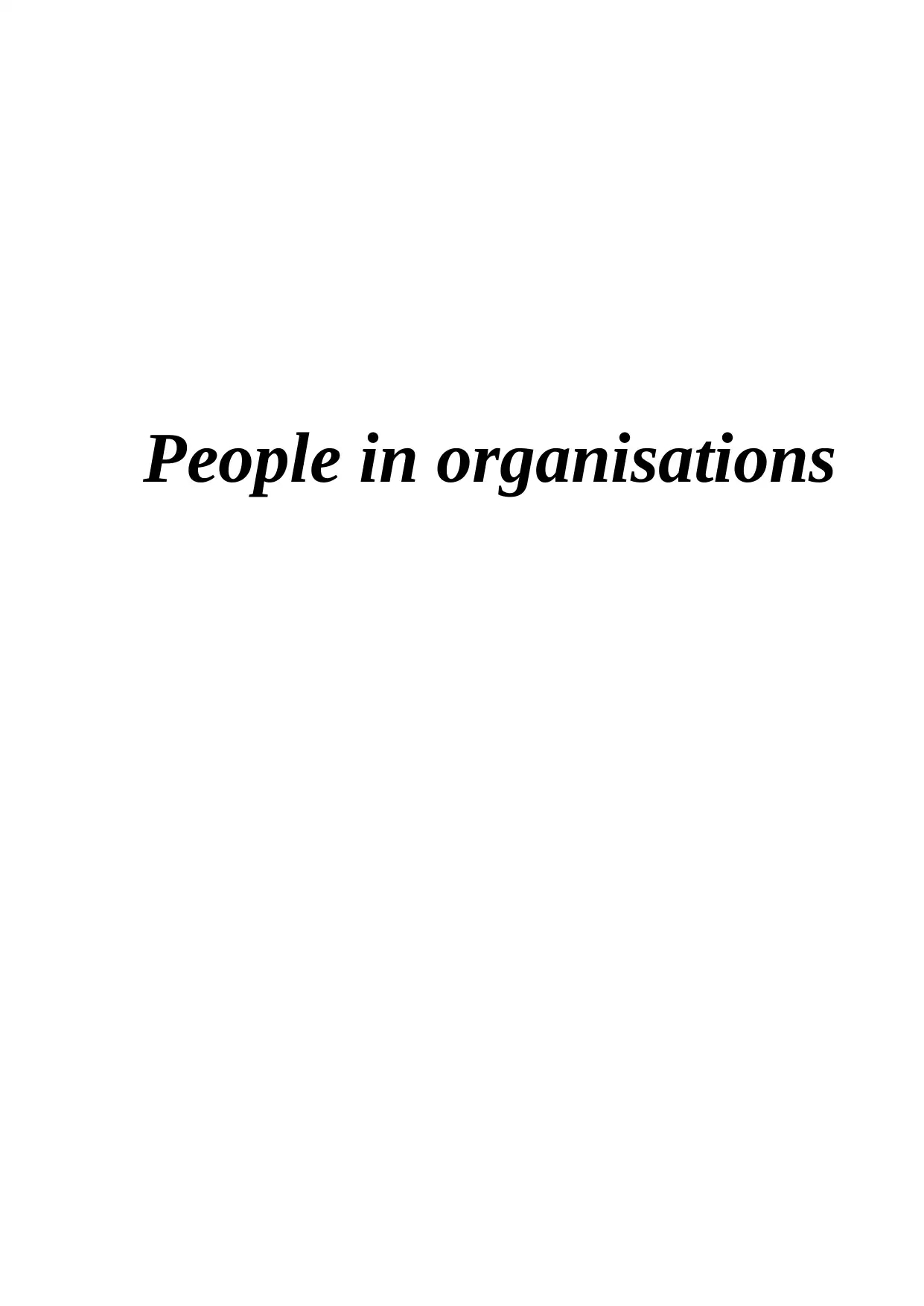
People in organisations
Paraphrase This Document
Need a fresh take? Get an instant paraphrase of this document with our AI Paraphraser
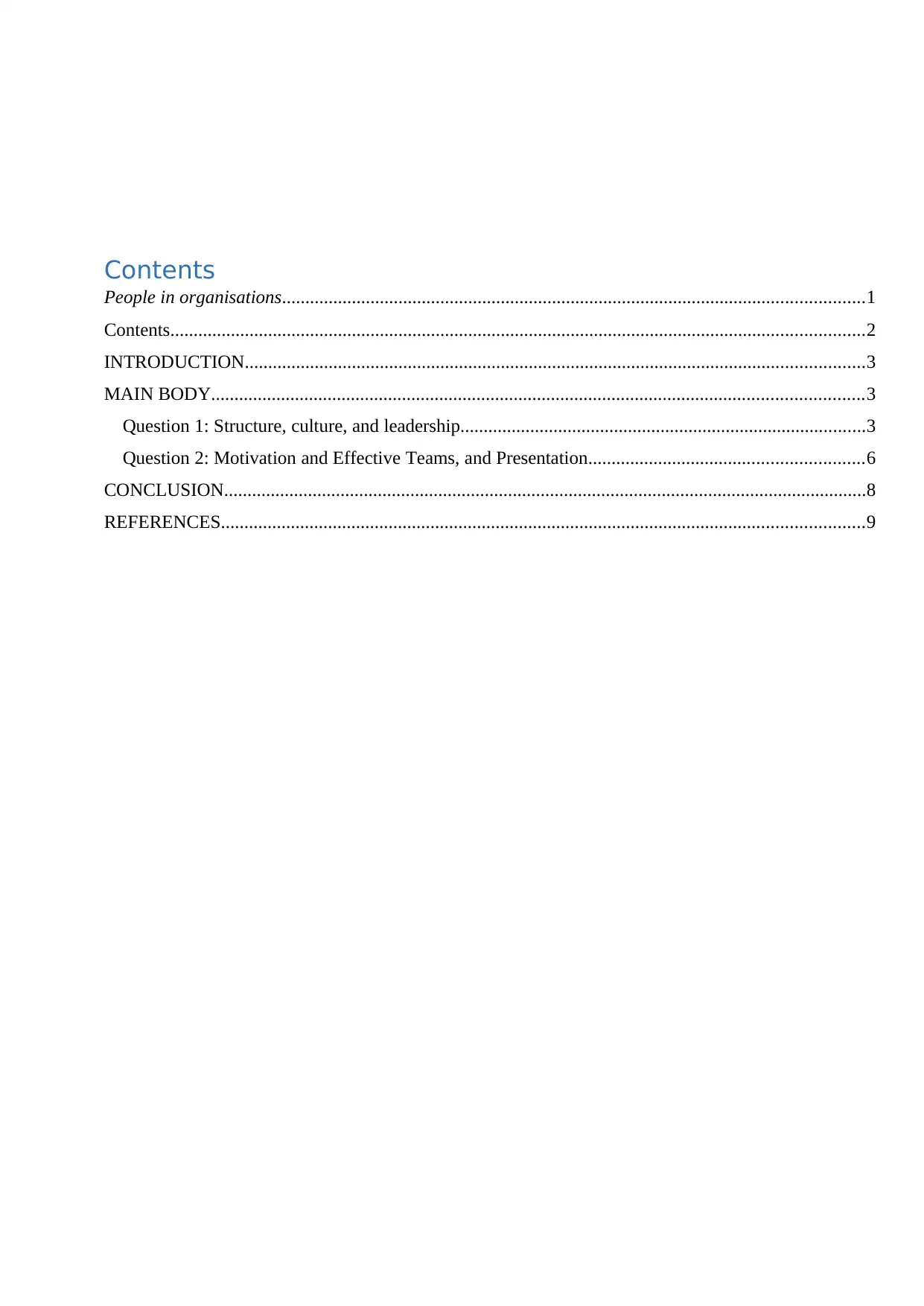
Contents
People in organisations.............................................................................................................................1
Contents.....................................................................................................................................................2
INTRODUCTION.....................................................................................................................................3
MAIN BODY............................................................................................................................................3
Question 1: Structure, culture, and leadership.......................................................................................3
Question 2: Motivation and Effective Teams, and Presentation...........................................................6
CONCLUSION..........................................................................................................................................8
REFERENCES..........................................................................................................................................9
People in organisations.............................................................................................................................1
Contents.....................................................................................................................................................2
INTRODUCTION.....................................................................................................................................3
MAIN BODY............................................................................................................................................3
Question 1: Structure, culture, and leadership.......................................................................................3
Question 2: Motivation and Effective Teams, and Presentation...........................................................6
CONCLUSION..........................................................................................................................................8
REFERENCES..........................................................................................................................................9
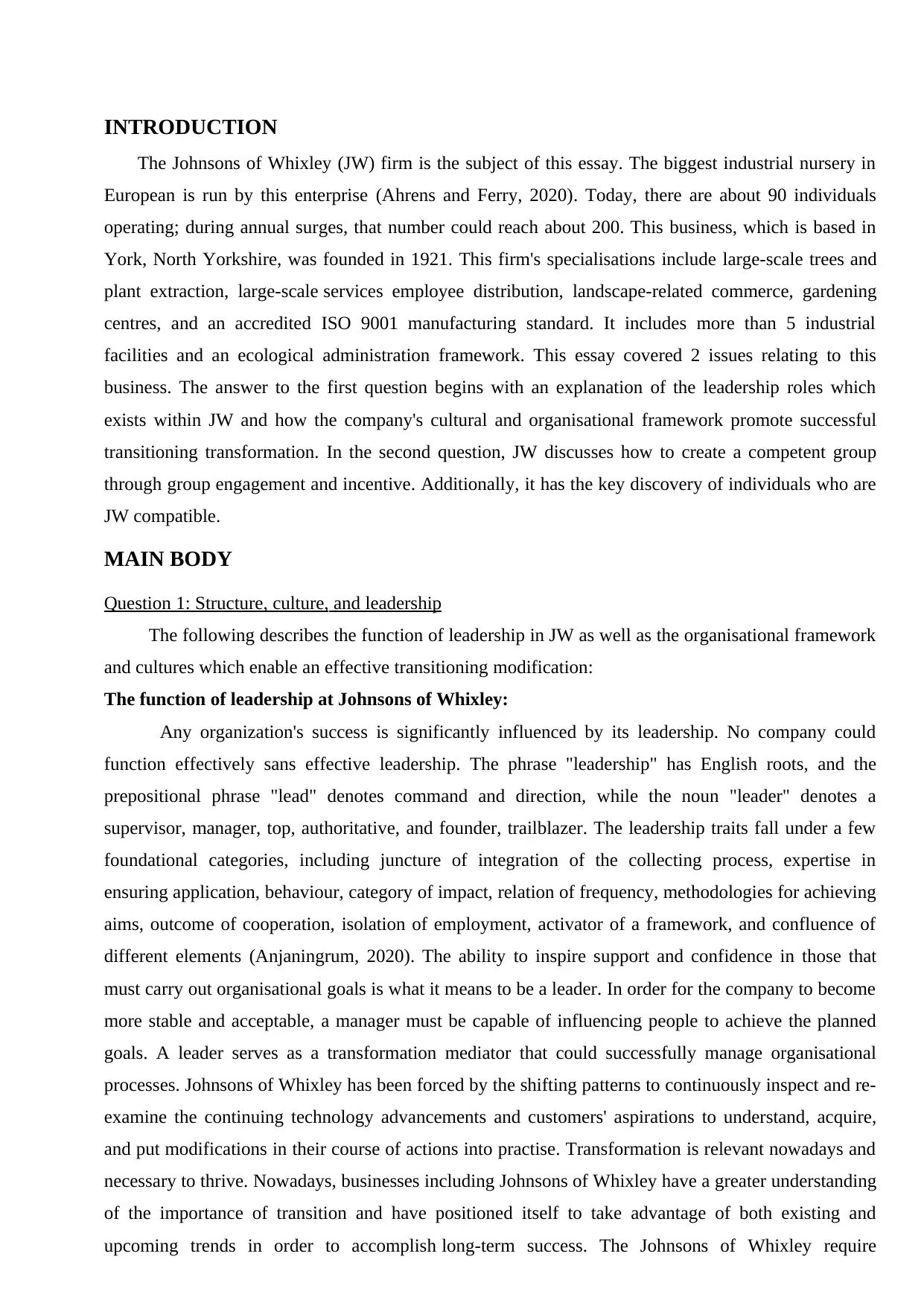
INTRODUCTION
The Johnsons of Whixley (JW) firm is the subject of this essay. The biggest industrial nursery in
European is run by this enterprise (Ahrens and Ferry, 2020). Today, there are about 90 individuals
operating; during annual surges, that number could reach about 200. This business, which is based in
York, North Yorkshire, was founded in 1921. This firm's specialisations include large-scale trees and
plant extraction, large-scale services employee distribution, landscape-related commerce, gardening
centres, and an accredited ISO 9001 manufacturing standard. It includes more than 5 industrial
facilities and an ecological administration framework. This essay covered 2 issues relating to this
business. The answer to the first question begins with an explanation of the leadership roles which
exists within JW and how the company's cultural and organisational framework promote successful
transitioning transformation. In the second question, JW discusses how to create a competent group
through group engagement and incentive. Additionally, it has the key discovery of individuals who are
JW compatible.
MAIN BODY
Question 1: Structure, culture, and leadership
The following describes the function of leadership in JW as well as the organisational framework
and cultures which enable an effective transitioning modification:
The function of leadership at Johnsons of Whixley:
Any organization's success is significantly influenced by its leadership. No company could
function effectively sans effective leadership. The phrase "leadership" has English roots, and the
prepositional phrase "lead" denotes command and direction, while the noun "leader" denotes a
supervisor, manager, top, authoritative, and founder, trailblazer. The leadership traits fall under a few
foundational categories, including juncture of integration of the collecting process, expertise in
ensuring application, behaviour, category of impact, relation of frequency, methodologies for achieving
aims, outcome of cooperation, isolation of employment, activator of a framework, and confluence of
different elements (Anjaningrum, 2020). The ability to inspire support and confidence in those that
must carry out organisational goals is what it means to be a leader. In order for the company to become
more stable and acceptable, a manager must be capable of influencing people to achieve the planned
goals. A leader serves as a transformation mediator that could successfully manage organisational
processes. Johnsons of Whixley has been forced by the shifting patterns to continuously inspect and re-
examine the continuing technology advancements and customers' aspirations to understand, acquire,
and put modifications in their course of actions into practise. Transformation is relevant nowadays and
necessary to thrive. Nowadays, businesses including Johnsons of Whixley have a greater understanding
of the importance of transition and have positioned itself to take advantage of both existing and
upcoming trends in order to accomplish long-term success. The Johnsons of Whixley require
The Johnsons of Whixley (JW) firm is the subject of this essay. The biggest industrial nursery in
European is run by this enterprise (Ahrens and Ferry, 2020). Today, there are about 90 individuals
operating; during annual surges, that number could reach about 200. This business, which is based in
York, North Yorkshire, was founded in 1921. This firm's specialisations include large-scale trees and
plant extraction, large-scale services employee distribution, landscape-related commerce, gardening
centres, and an accredited ISO 9001 manufacturing standard. It includes more than 5 industrial
facilities and an ecological administration framework. This essay covered 2 issues relating to this
business. The answer to the first question begins with an explanation of the leadership roles which
exists within JW and how the company's cultural and organisational framework promote successful
transitioning transformation. In the second question, JW discusses how to create a competent group
through group engagement and incentive. Additionally, it has the key discovery of individuals who are
JW compatible.
MAIN BODY
Question 1: Structure, culture, and leadership
The following describes the function of leadership in JW as well as the organisational framework
and cultures which enable an effective transitioning modification:
The function of leadership at Johnsons of Whixley:
Any organization's success is significantly influenced by its leadership. No company could
function effectively sans effective leadership. The phrase "leadership" has English roots, and the
prepositional phrase "lead" denotes command and direction, while the noun "leader" denotes a
supervisor, manager, top, authoritative, and founder, trailblazer. The leadership traits fall under a few
foundational categories, including juncture of integration of the collecting process, expertise in
ensuring application, behaviour, category of impact, relation of frequency, methodologies for achieving
aims, outcome of cooperation, isolation of employment, activator of a framework, and confluence of
different elements (Anjaningrum, 2020). The ability to inspire support and confidence in those that
must carry out organisational goals is what it means to be a leader. In order for the company to become
more stable and acceptable, a manager must be capable of influencing people to achieve the planned
goals. A leader serves as a transformation mediator that could successfully manage organisational
processes. Johnsons of Whixley has been forced by the shifting patterns to continuously inspect and re-
examine the continuing technology advancements and customers' aspirations to understand, acquire,
and put modifications in their course of actions into practise. Transformation is relevant nowadays and
necessary to thrive. Nowadays, businesses including Johnsons of Whixley have a greater understanding
of the importance of transition and have positioned itself to take advantage of both existing and
upcoming trends in order to accomplish long-term success. The Johnsons of Whixley require
⊘ This is a preview!⊘
Do you want full access?
Subscribe today to unlock all pages.

Trusted by 1+ million students worldwide
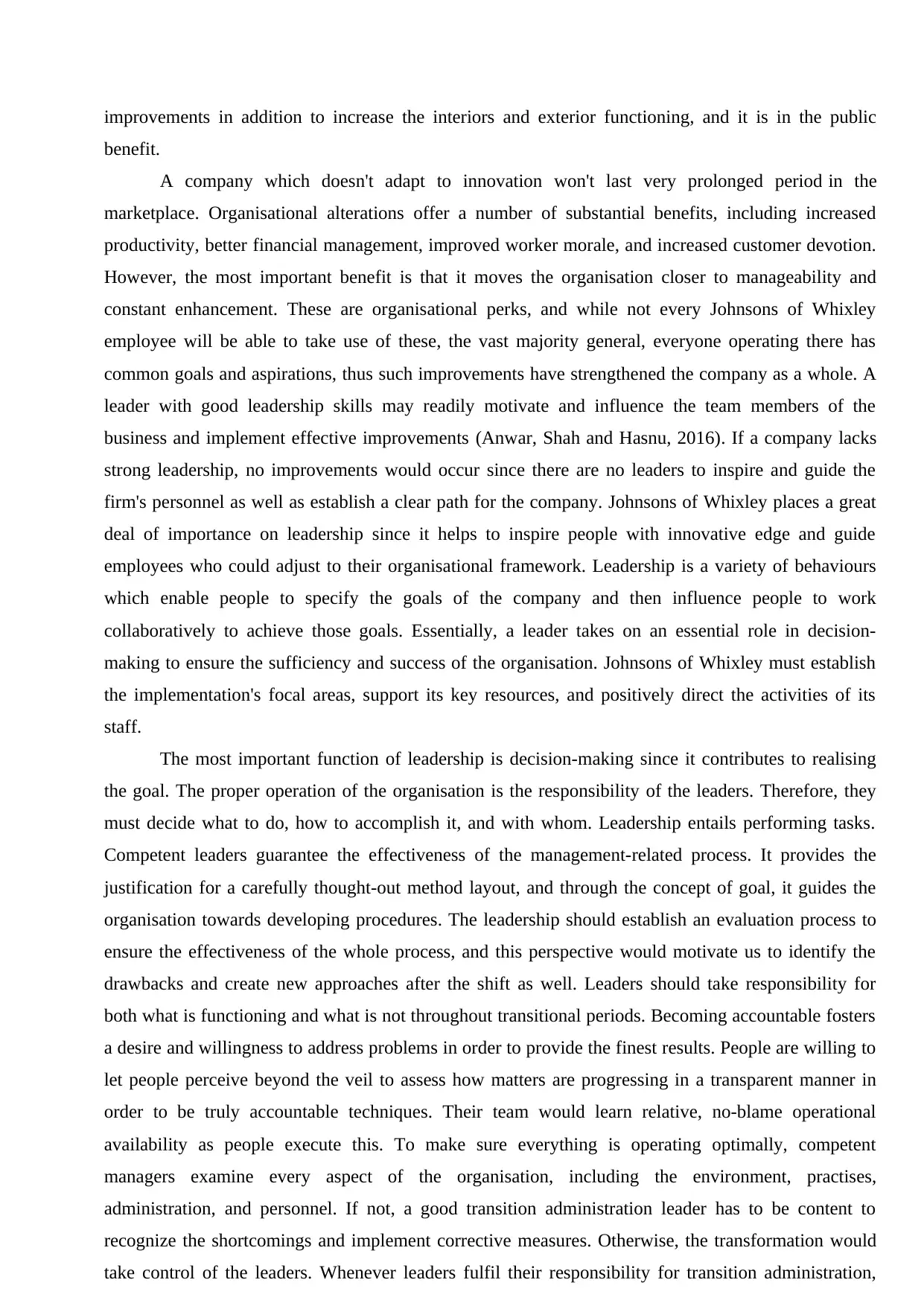
improvements in addition to increase the interiors and exterior functioning, and it is in the public
benefit.
A company which doesn't adapt to innovation won't last very prolonged period in the
marketplace. Organisational alterations offer a number of substantial benefits, including increased
productivity, better financial management, improved worker morale, and increased customer devotion.
However, the most important benefit is that it moves the organisation closer to manageability and
constant enhancement. These are organisational perks, and while not every Johnsons of Whixley
employee will be able to take use of these, the vast majority general, everyone operating there has
common goals and aspirations, thus such improvements have strengthened the company as a whole. A
leader with good leadership skills may readily motivate and influence the team members of the
business and implement effective improvements (Anwar, Shah and Hasnu, 2016). If a company lacks
strong leadership, no improvements would occur since there are no leaders to inspire and guide the
firm's personnel as well as establish a clear path for the company. Johnsons of Whixley places a great
deal of importance on leadership since it helps to inspire people with innovative edge and guide
employees who could adjust to their organisational framework. Leadership is a variety of behaviours
which enable people to specify the goals of the company and then influence people to work
collaboratively to achieve those goals. Essentially, a leader takes on an essential role in decision-
making to ensure the sufficiency and success of the organisation. Johnsons of Whixley must establish
the implementation's focal areas, support its key resources, and positively direct the activities of its
staff.
The most important function of leadership is decision-making since it contributes to realising
the goal. The proper operation of the organisation is the responsibility of the leaders. Therefore, they
must decide what to do, how to accomplish it, and with whom. Leadership entails performing tasks.
Competent leaders guarantee the effectiveness of the management-related process. It provides the
justification for a carefully thought-out method layout, and through the concept of goal, it guides the
organisation towards developing procedures. The leadership should establish an evaluation process to
ensure the effectiveness of the whole process, and this perspective would motivate us to identify the
drawbacks and create new approaches after the shift as well. Leaders should take responsibility for
both what is functioning and what is not throughout transitional periods. Becoming accountable fosters
a desire and willingness to address problems in order to provide the finest results. People are willing to
let people perceive beyond the veil to assess how matters are progressing in a transparent manner in
order to be truly accountable techniques. Their team would learn relative, no-blame operational
availability as people execute this. To make sure everything is operating optimally, competent
managers examine every aspect of the organisation, including the environment, practises,
administration, and personnel. If not, a good transition administration leader has to be content to
recognize the shortcomings and implement corrective measures. Otherwise, the transformation would
take control of the leaders. Whenever leaders fulfil their responsibility for transition administration,
benefit.
A company which doesn't adapt to innovation won't last very prolonged period in the
marketplace. Organisational alterations offer a number of substantial benefits, including increased
productivity, better financial management, improved worker morale, and increased customer devotion.
However, the most important benefit is that it moves the organisation closer to manageability and
constant enhancement. These are organisational perks, and while not every Johnsons of Whixley
employee will be able to take use of these, the vast majority general, everyone operating there has
common goals and aspirations, thus such improvements have strengthened the company as a whole. A
leader with good leadership skills may readily motivate and influence the team members of the
business and implement effective improvements (Anwar, Shah and Hasnu, 2016). If a company lacks
strong leadership, no improvements would occur since there are no leaders to inspire and guide the
firm's personnel as well as establish a clear path for the company. Johnsons of Whixley places a great
deal of importance on leadership since it helps to inspire people with innovative edge and guide
employees who could adjust to their organisational framework. Leadership is a variety of behaviours
which enable people to specify the goals of the company and then influence people to work
collaboratively to achieve those goals. Essentially, a leader takes on an essential role in decision-
making to ensure the sufficiency and success of the organisation. Johnsons of Whixley must establish
the implementation's focal areas, support its key resources, and positively direct the activities of its
staff.
The most important function of leadership is decision-making since it contributes to realising
the goal. The proper operation of the organisation is the responsibility of the leaders. Therefore, they
must decide what to do, how to accomplish it, and with whom. Leadership entails performing tasks.
Competent leaders guarantee the effectiveness of the management-related process. It provides the
justification for a carefully thought-out method layout, and through the concept of goal, it guides the
organisation towards developing procedures. The leadership should establish an evaluation process to
ensure the effectiveness of the whole process, and this perspective would motivate us to identify the
drawbacks and create new approaches after the shift as well. Leaders should take responsibility for
both what is functioning and what is not throughout transitional periods. Becoming accountable fosters
a desire and willingness to address problems in order to provide the finest results. People are willing to
let people perceive beyond the veil to assess how matters are progressing in a transparent manner in
order to be truly accountable techniques. Their team would learn relative, no-blame operational
availability as people execute this. To make sure everything is operating optimally, competent
managers examine every aspect of the organisation, including the environment, practises,
administration, and personnel. If not, a good transition administration leader has to be content to
recognize the shortcomings and implement corrective measures. Otherwise, the transformation would
take control of the leaders. Whenever leaders fulfil their responsibility for transition administration,
Paraphrase This Document
Need a fresh take? Get an instant paraphrase of this document with our AI Paraphraser
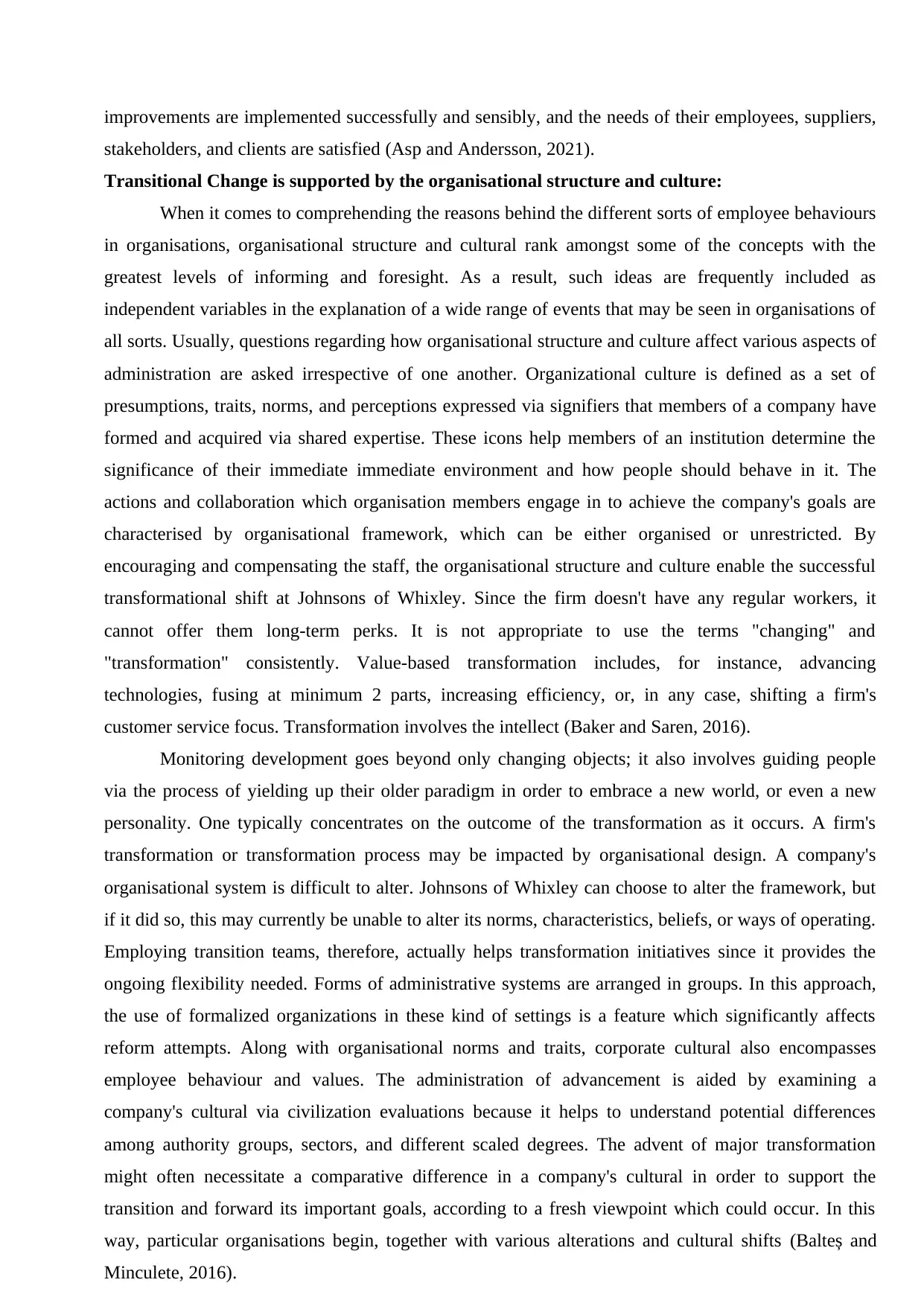
improvements are implemented successfully and sensibly, and the needs of their employees, suppliers,
stakeholders, and clients are satisfied (Asp and Andersson, 2021).
Transitional Change is supported by the organisational structure and culture:
When it comes to comprehending the reasons behind the different sorts of employee behaviours
in organisations, organisational structure and cultural rank amongst some of the concepts with the
greatest levels of informing and foresight. As a result, such ideas are frequently included as
independent variables in the explanation of a wide range of events that may be seen in organisations of
all sorts. Usually, questions regarding how organisational structure and culture affect various aspects of
administration are asked irrespective of one another. Organizational culture is defined as a set of
presumptions, traits, norms, and perceptions expressed via signifiers that members of a company have
formed and acquired via shared expertise. These icons help members of an institution determine the
significance of their immediate immediate environment and how people should behave in it. The
actions and collaboration which organisation members engage in to achieve the company's goals are
characterised by organisational framework, which can be either organised or unrestricted. By
encouraging and compensating the staff, the organisational structure and culture enable the successful
transformational shift at Johnsons of Whixley. Since the firm doesn't have any regular workers, it
cannot offer them long-term perks. It is not appropriate to use the terms "changing" and
"transformation" consistently. Value-based transformation includes, for instance, advancing
technologies, fusing at minimum 2 parts, increasing efficiency, or, in any case, shifting a firm's
customer service focus. Transformation involves the intellect (Baker and Saren, 2016).
Monitoring development goes beyond only changing objects; it also involves guiding people
via the process of yielding up their older paradigm in order to embrace a new world, or even a new
personality. One typically concentrates on the outcome of the transformation as it occurs. A firm's
transformation or transformation process may be impacted by organisational design. A company's
organisational system is difficult to alter. Johnsons of Whixley can choose to alter the framework, but
if it did so, this may currently be unable to alter its norms, characteristics, beliefs, or ways of operating.
Employing transition teams, therefore, actually helps transformation initiatives since it provides the
ongoing flexibility needed. Forms of administrative systems are arranged in groups. In this approach,
the use of formalized organizations in these kind of settings is a feature which significantly affects
reform attempts. Along with organisational norms and traits, corporate cultural also encompasses
employee behaviour and values. The administration of advancement is aided by examining a
company's cultural via civilization evaluations because it helps to understand potential differences
among authority groups, sectors, and different scaled degrees. The advent of major transformation
might often necessitate a comparative difference in a company's cultural in order to support the
transition and forward its important goals, according to a fresh viewpoint which could occur. In this
way, particular organisations begin, together with various alterations and cultural shifts (Balteș and
Minculete, 2016).
stakeholders, and clients are satisfied (Asp and Andersson, 2021).
Transitional Change is supported by the organisational structure and culture:
When it comes to comprehending the reasons behind the different sorts of employee behaviours
in organisations, organisational structure and cultural rank amongst some of the concepts with the
greatest levels of informing and foresight. As a result, such ideas are frequently included as
independent variables in the explanation of a wide range of events that may be seen in organisations of
all sorts. Usually, questions regarding how organisational structure and culture affect various aspects of
administration are asked irrespective of one another. Organizational culture is defined as a set of
presumptions, traits, norms, and perceptions expressed via signifiers that members of a company have
formed and acquired via shared expertise. These icons help members of an institution determine the
significance of their immediate immediate environment and how people should behave in it. The
actions and collaboration which organisation members engage in to achieve the company's goals are
characterised by organisational framework, which can be either organised or unrestricted. By
encouraging and compensating the staff, the organisational structure and culture enable the successful
transformational shift at Johnsons of Whixley. Since the firm doesn't have any regular workers, it
cannot offer them long-term perks. It is not appropriate to use the terms "changing" and
"transformation" consistently. Value-based transformation includes, for instance, advancing
technologies, fusing at minimum 2 parts, increasing efficiency, or, in any case, shifting a firm's
customer service focus. Transformation involves the intellect (Baker and Saren, 2016).
Monitoring development goes beyond only changing objects; it also involves guiding people
via the process of yielding up their older paradigm in order to embrace a new world, or even a new
personality. One typically concentrates on the outcome of the transformation as it occurs. A firm's
transformation or transformation process may be impacted by organisational design. A company's
organisational system is difficult to alter. Johnsons of Whixley can choose to alter the framework, but
if it did so, this may currently be unable to alter its norms, characteristics, beliefs, or ways of operating.
Employing transition teams, therefore, actually helps transformation initiatives since it provides the
ongoing flexibility needed. Forms of administrative systems are arranged in groups. In this approach,
the use of formalized organizations in these kind of settings is a feature which significantly affects
reform attempts. Along with organisational norms and traits, corporate cultural also encompasses
employee behaviour and values. The administration of advancement is aided by examining a
company's cultural via civilization evaluations because it helps to understand potential differences
among authority groups, sectors, and different scaled degrees. The advent of major transformation
might often necessitate a comparative difference in a company's cultural in order to support the
transition and forward its important goals, according to a fresh viewpoint which could occur. In this
way, particular organisations begin, together with various alterations and cultural shifts (Balteș and
Minculete, 2016).
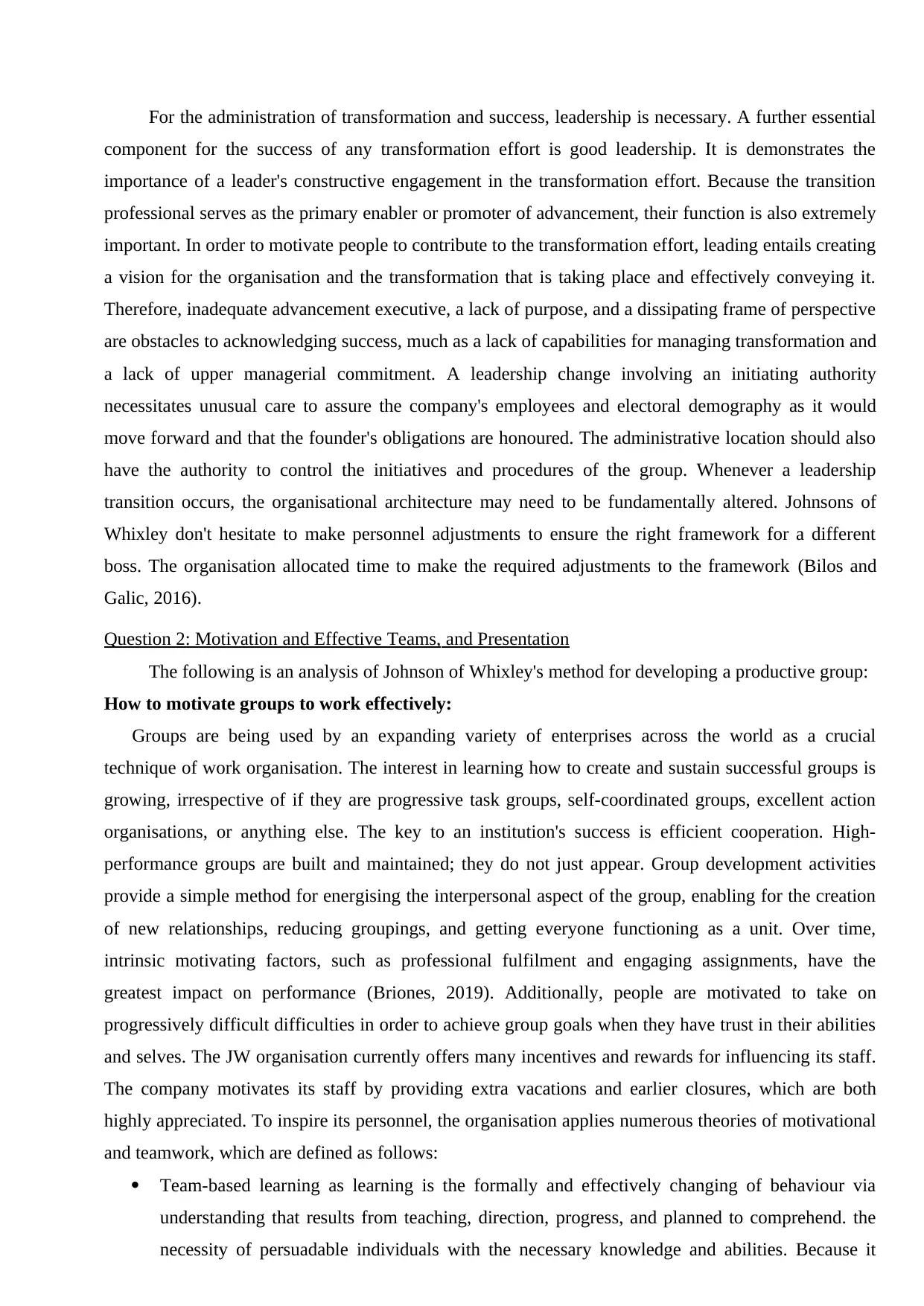
For the administration of transformation and success, leadership is necessary. A further essential
component for the success of any transformation effort is good leadership. It is demonstrates the
importance of a leader's constructive engagement in the transformation effort. Because the transition
professional serves as the primary enabler or promoter of advancement, their function is also extremely
important. In order to motivate people to contribute to the transformation effort, leading entails creating
a vision for the organisation and the transformation that is taking place and effectively conveying it.
Therefore, inadequate advancement executive, a lack of purpose, and a dissipating frame of perspective
are obstacles to acknowledging success, much as a lack of capabilities for managing transformation and
a lack of upper managerial commitment. A leadership change involving an initiating authority
necessitates unusual care to assure the company's employees and electoral demography as it would
move forward and that the founder's obligations are honoured. The administrative location should also
have the authority to control the initiatives and procedures of the group. Whenever a leadership
transition occurs, the organisational architecture may need to be fundamentally altered. Johnsons of
Whixley don't hesitate to make personnel adjustments to ensure the right framework for a different
boss. The organisation allocated time to make the required adjustments to the framework (Bilos and
Galic, 2016).
Question 2: Motivation and Effective Teams, and Presentation
The following is an analysis of Johnson of Whixley's method for developing a productive group:
How to motivate groups to work effectively:
Groups are being used by an expanding variety of enterprises across the world as a crucial
technique of work organisation. The interest in learning how to create and sustain successful groups is
growing, irrespective of if they are progressive task groups, self-coordinated groups, excellent action
organisations, or anything else. The key to an institution's success is efficient cooperation. High-
performance groups are built and maintained; they do not just appear. Group development activities
provide a simple method for energising the interpersonal aspect of the group, enabling for the creation
of new relationships, reducing groupings, and getting everyone functioning as a unit. Over time,
intrinsic motivating factors, such as professional fulfilment and engaging assignments, have the
greatest impact on performance (Briones, 2019). Additionally, people are motivated to take on
progressively difficult difficulties in order to achieve group goals when they have trust in their abilities
and selves. The JW organisation currently offers many incentives and rewards for influencing its staff.
The company motivates its staff by providing extra vacations and earlier closures, which are both
highly appreciated. To inspire its personnel, the organisation applies numerous theories of motivational
and teamwork, which are defined as follows:
Team-based learning as learning is the formally and effectively changing of behaviour via
understanding that results from teaching, direction, progress, and planned to comprehend. the
necessity of persuadable individuals with the necessary knowledge and abilities. Because it
component for the success of any transformation effort is good leadership. It is demonstrates the
importance of a leader's constructive engagement in the transformation effort. Because the transition
professional serves as the primary enabler or promoter of advancement, their function is also extremely
important. In order to motivate people to contribute to the transformation effort, leading entails creating
a vision for the organisation and the transformation that is taking place and effectively conveying it.
Therefore, inadequate advancement executive, a lack of purpose, and a dissipating frame of perspective
are obstacles to acknowledging success, much as a lack of capabilities for managing transformation and
a lack of upper managerial commitment. A leadership change involving an initiating authority
necessitates unusual care to assure the company's employees and electoral demography as it would
move forward and that the founder's obligations are honoured. The administrative location should also
have the authority to control the initiatives and procedures of the group. Whenever a leadership
transition occurs, the organisational architecture may need to be fundamentally altered. Johnsons of
Whixley don't hesitate to make personnel adjustments to ensure the right framework for a different
boss. The organisation allocated time to make the required adjustments to the framework (Bilos and
Galic, 2016).
Question 2: Motivation and Effective Teams, and Presentation
The following is an analysis of Johnson of Whixley's method for developing a productive group:
How to motivate groups to work effectively:
Groups are being used by an expanding variety of enterprises across the world as a crucial
technique of work organisation. The interest in learning how to create and sustain successful groups is
growing, irrespective of if they are progressive task groups, self-coordinated groups, excellent action
organisations, or anything else. The key to an institution's success is efficient cooperation. High-
performance groups are built and maintained; they do not just appear. Group development activities
provide a simple method for energising the interpersonal aspect of the group, enabling for the creation
of new relationships, reducing groupings, and getting everyone functioning as a unit. Over time,
intrinsic motivating factors, such as professional fulfilment and engaging assignments, have the
greatest impact on performance (Briones, 2019). Additionally, people are motivated to take on
progressively difficult difficulties in order to achieve group goals when they have trust in their abilities
and selves. The JW organisation currently offers many incentives and rewards for influencing its staff.
The company motivates its staff by providing extra vacations and earlier closures, which are both
highly appreciated. To inspire its personnel, the organisation applies numerous theories of motivational
and teamwork, which are defined as follows:
Team-based learning as learning is the formally and effectively changing of behaviour via
understanding that results from teaching, direction, progress, and planned to comprehend. the
necessity of persuadable individuals with the necessary knowledge and abilities. Because it
⊘ This is a preview!⊘
Do you want full access?
Subscribe today to unlock all pages.

Trusted by 1+ million students worldwide
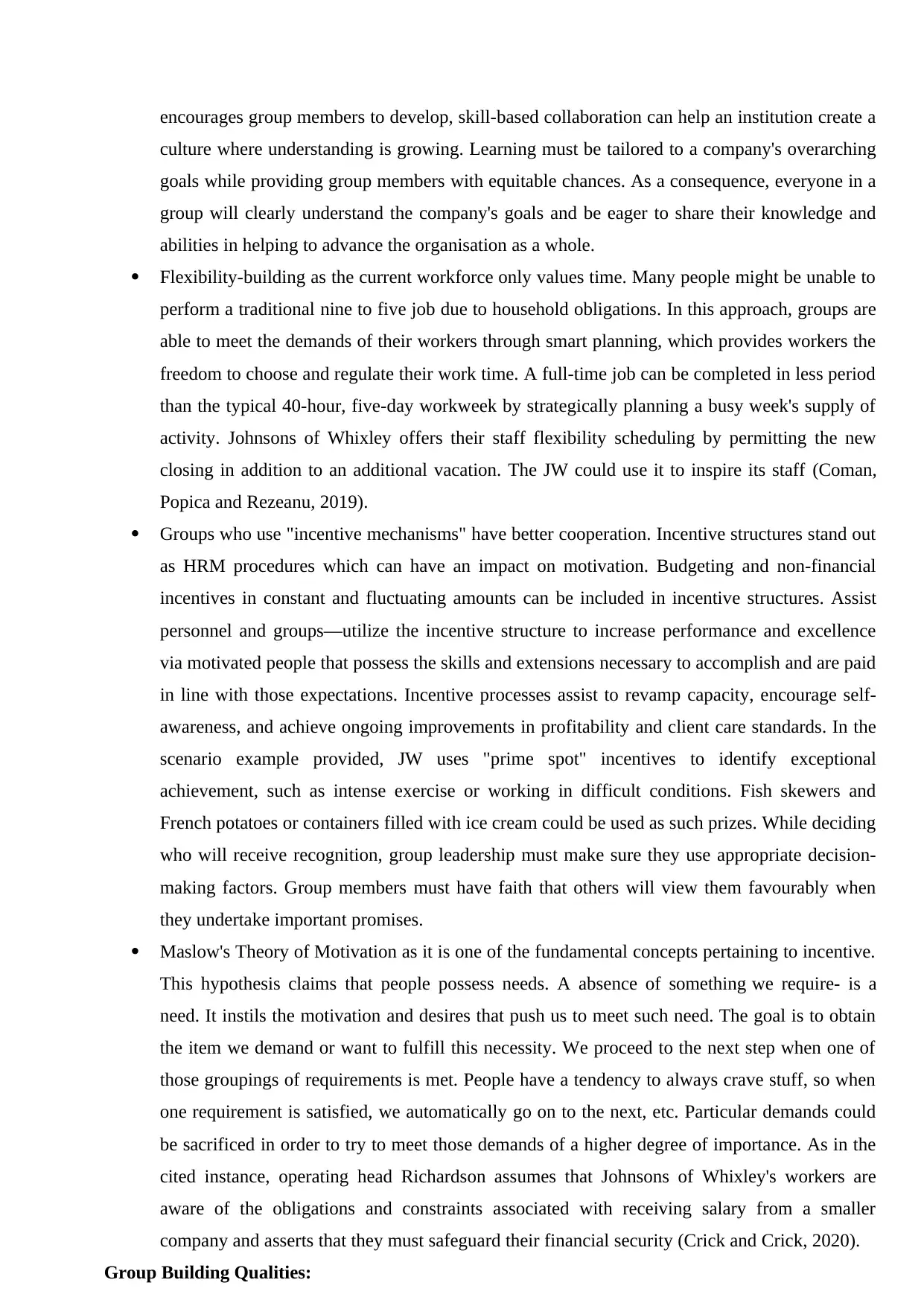
encourages group members to develop, skill-based collaboration can help an institution create a
culture where understanding is growing. Learning must be tailored to a company's overarching
goals while providing group members with equitable chances. As a consequence, everyone in a
group will clearly understand the company's goals and be eager to share their knowledge and
abilities in helping to advance the organisation as a whole.
Flexibility-building as the current workforce only values time. Many people might be unable to
perform a traditional nine to five job due to household obligations. In this approach, groups are
able to meet the demands of their workers through smart planning, which provides workers the
freedom to choose and regulate their work time. A full-time job can be completed in less period
than the typical 40-hour, five-day workweek by strategically planning a busy week's supply of
activity. Johnsons of Whixley offers their staff flexibility scheduling by permitting the new
closing in addition to an additional vacation. The JW could use it to inspire its staff (Coman,
Popica and Rezeanu, 2019).
Groups who use "incentive mechanisms" have better cooperation. Incentive structures stand out
as HRM procedures which can have an impact on motivation. Budgeting and non-financial
incentives in constant and fluctuating amounts can be included in incentive structures. Assist
personnel and groups—utilize the incentive structure to increase performance and excellence
via motivated people that possess the skills and extensions necessary to accomplish and are paid
in line with those expectations. Incentive processes assist to revamp capacity, encourage self-
awareness, and achieve ongoing improvements in profitability and client care standards. In the
scenario example provided, JW uses "prime spot" incentives to identify exceptional
achievement, such as intense exercise or working in difficult conditions. Fish skewers and
French potatoes or containers filled with ice cream could be used as such prizes. While deciding
who will receive recognition, group leadership must make sure they use appropriate decision-
making factors. Group members must have faith that others will view them favourably when
they undertake important promises.
Maslow's Theory of Motivation as it is one of the fundamental concepts pertaining to incentive.
This hypothesis claims that people possess needs. A absence of something we require- is a
need. It instils the motivation and desires that push us to meet such need. The goal is to obtain
the item we demand or want to fulfill this necessity. We proceed to the next step when one of
those groupings of requirements is met. People have a tendency to always crave stuff, so when
one requirement is satisfied, we automatically go on to the next, etc. Particular demands could
be sacrificed in order to try to meet those demands of a higher degree of importance. As in the
cited instance, operating head Richardson assumes that Johnsons of Whixley's workers are
aware of the obligations and constraints associated with receiving salary from a smaller
company and asserts that they must safeguard their financial security (Crick and Crick, 2020).
Group Building Qualities:
culture where understanding is growing. Learning must be tailored to a company's overarching
goals while providing group members with equitable chances. As a consequence, everyone in a
group will clearly understand the company's goals and be eager to share their knowledge and
abilities in helping to advance the organisation as a whole.
Flexibility-building as the current workforce only values time. Many people might be unable to
perform a traditional nine to five job due to household obligations. In this approach, groups are
able to meet the demands of their workers through smart planning, which provides workers the
freedom to choose and regulate their work time. A full-time job can be completed in less period
than the typical 40-hour, five-day workweek by strategically planning a busy week's supply of
activity. Johnsons of Whixley offers their staff flexibility scheduling by permitting the new
closing in addition to an additional vacation. The JW could use it to inspire its staff (Coman,
Popica and Rezeanu, 2019).
Groups who use "incentive mechanisms" have better cooperation. Incentive structures stand out
as HRM procedures which can have an impact on motivation. Budgeting and non-financial
incentives in constant and fluctuating amounts can be included in incentive structures. Assist
personnel and groups—utilize the incentive structure to increase performance and excellence
via motivated people that possess the skills and extensions necessary to accomplish and are paid
in line with those expectations. Incentive processes assist to revamp capacity, encourage self-
awareness, and achieve ongoing improvements in profitability and client care standards. In the
scenario example provided, JW uses "prime spot" incentives to identify exceptional
achievement, such as intense exercise or working in difficult conditions. Fish skewers and
French potatoes or containers filled with ice cream could be used as such prizes. While deciding
who will receive recognition, group leadership must make sure they use appropriate decision-
making factors. Group members must have faith that others will view them favourably when
they undertake important promises.
Maslow's Theory of Motivation as it is one of the fundamental concepts pertaining to incentive.
This hypothesis claims that people possess needs. A absence of something we require- is a
need. It instils the motivation and desires that push us to meet such need. The goal is to obtain
the item we demand or want to fulfill this necessity. We proceed to the next step when one of
those groupings of requirements is met. People have a tendency to always crave stuff, so when
one requirement is satisfied, we automatically go on to the next, etc. Particular demands could
be sacrificed in order to try to meet those demands of a higher degree of importance. As in the
cited instance, operating head Richardson assumes that Johnsons of Whixley's workers are
aware of the obligations and constraints associated with receiving salary from a smaller
company and asserts that they must safeguard their financial security (Crick and Crick, 2020).
Group Building Qualities:
Paraphrase This Document
Need a fresh take? Get an instant paraphrase of this document with our AI Paraphraser
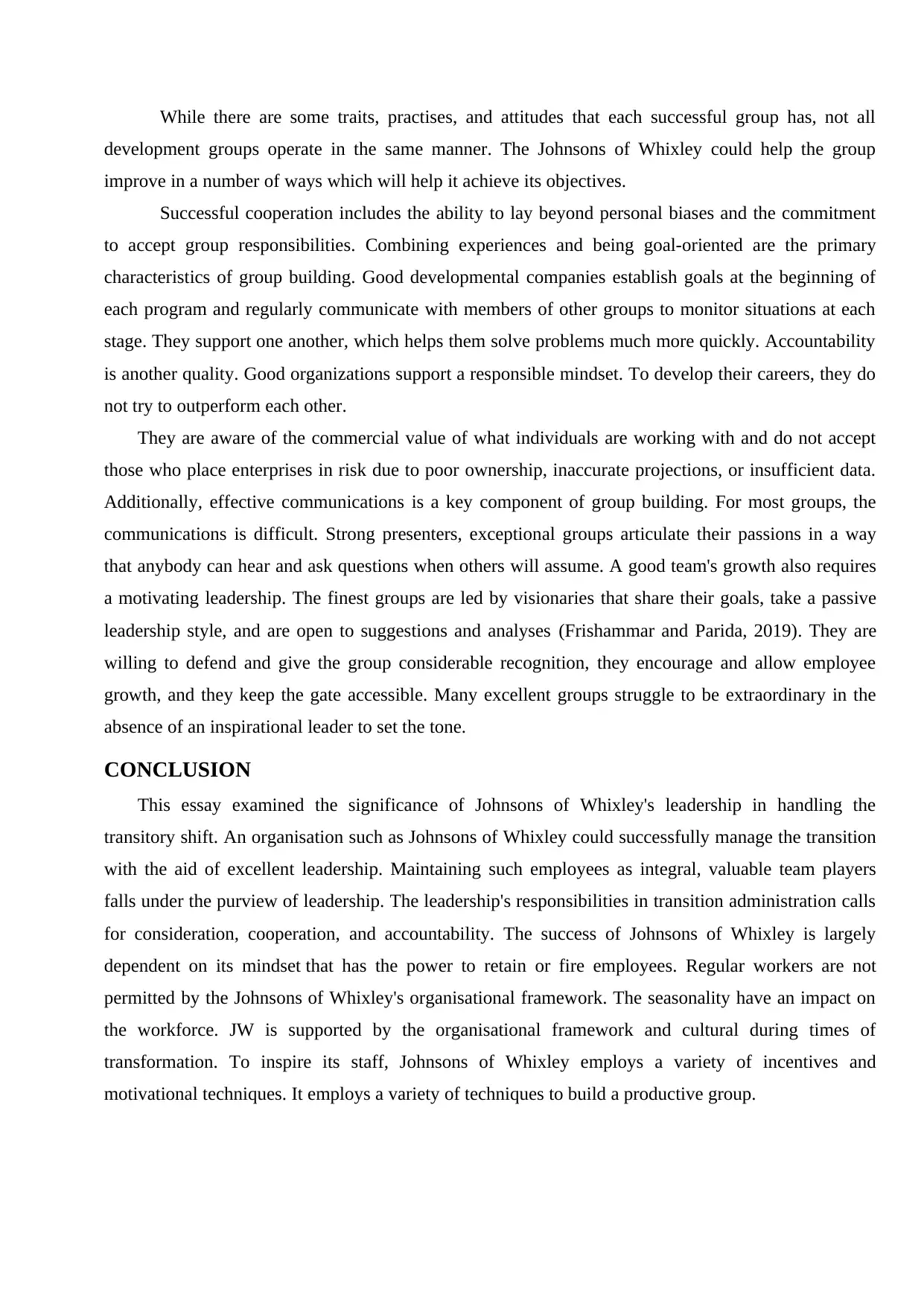
While there are some traits, practises, and attitudes that each successful group has, not all
development groups operate in the same manner. The Johnsons of Whixley could help the group
improve in a number of ways which will help it achieve its objectives.
Successful cooperation includes the ability to lay beyond personal biases and the commitment
to accept group responsibilities. Combining experiences and being goal-oriented are the primary
characteristics of group building. Good developmental companies establish goals at the beginning of
each program and regularly communicate with members of other groups to monitor situations at each
stage. They support one another, which helps them solve problems much more quickly. Accountability
is another quality. Good organizations support a responsible mindset. To develop their careers, they do
not try to outperform each other.
They are aware of the commercial value of what individuals are working with and do not accept
those who place enterprises in risk due to poor ownership, inaccurate projections, or insufficient data.
Additionally, effective communications is a key component of group building. For most groups, the
communications is difficult. Strong presenters, exceptional groups articulate their passions in a way
that anybody can hear and ask questions when others will assume. A good team's growth also requires
a motivating leadership. The finest groups are led by visionaries that share their goals, take a passive
leadership style, and are open to suggestions and analyses (Frishammar and Parida, 2019). They are
willing to defend and give the group considerable recognition, they encourage and allow employee
growth, and they keep the gate accessible. Many excellent groups struggle to be extraordinary in the
absence of an inspirational leader to set the tone.
CONCLUSION
This essay examined the significance of Johnsons of Whixley's leadership in handling the
transitory shift. An organisation such as Johnsons of Whixley could successfully manage the transition
with the aid of excellent leadership. Maintaining such employees as integral, valuable team players
falls under the purview of leadership. The leadership's responsibilities in transition administration calls
for consideration, cooperation, and accountability. The success of Johnsons of Whixley is largely
dependent on its mindset that has the power to retain or fire employees. Regular workers are not
permitted by the Johnsons of Whixley's organisational framework. The seasonality have an impact on
the workforce. JW is supported by the organisational framework and cultural during times of
transformation. To inspire its staff, Johnsons of Whixley employs a variety of incentives and
motivational techniques. It employs a variety of techniques to build a productive group.
development groups operate in the same manner. The Johnsons of Whixley could help the group
improve in a number of ways which will help it achieve its objectives.
Successful cooperation includes the ability to lay beyond personal biases and the commitment
to accept group responsibilities. Combining experiences and being goal-oriented are the primary
characteristics of group building. Good developmental companies establish goals at the beginning of
each program and regularly communicate with members of other groups to monitor situations at each
stage. They support one another, which helps them solve problems much more quickly. Accountability
is another quality. Good organizations support a responsible mindset. To develop their careers, they do
not try to outperform each other.
They are aware of the commercial value of what individuals are working with and do not accept
those who place enterprises in risk due to poor ownership, inaccurate projections, or insufficient data.
Additionally, effective communications is a key component of group building. For most groups, the
communications is difficult. Strong presenters, exceptional groups articulate their passions in a way
that anybody can hear and ask questions when others will assume. A good team's growth also requires
a motivating leadership. The finest groups are led by visionaries that share their goals, take a passive
leadership style, and are open to suggestions and analyses (Frishammar and Parida, 2019). They are
willing to defend and give the group considerable recognition, they encourage and allow employee
growth, and they keep the gate accessible. Many excellent groups struggle to be extraordinary in the
absence of an inspirational leader to set the tone.
CONCLUSION
This essay examined the significance of Johnsons of Whixley's leadership in handling the
transitory shift. An organisation such as Johnsons of Whixley could successfully manage the transition
with the aid of excellent leadership. Maintaining such employees as integral, valuable team players
falls under the purview of leadership. The leadership's responsibilities in transition administration calls
for consideration, cooperation, and accountability. The success of Johnsons of Whixley is largely
dependent on its mindset that has the power to retain or fire employees. Regular workers are not
permitted by the Johnsons of Whixley's organisational framework. The seasonality have an impact on
the workforce. JW is supported by the organisational framework and cultural during times of
transformation. To inspire its staff, Johnsons of Whixley employs a variety of incentives and
motivational techniques. It employs a variety of techniques to build a productive group.
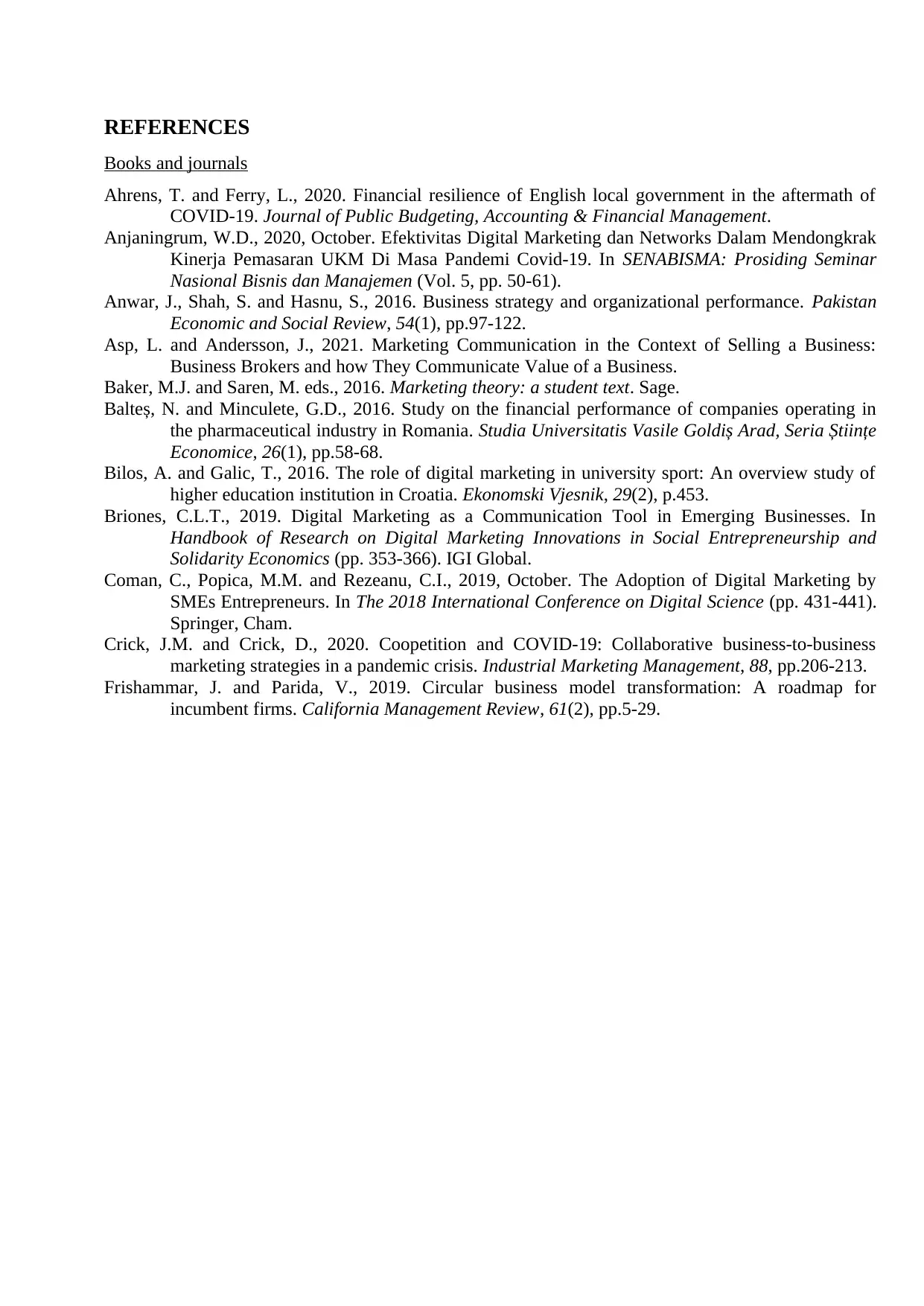
REFERENCES
Books and journals
Ahrens, T. and Ferry, L., 2020. Financial resilience of English local government in the aftermath of
COVID-19. Journal of Public Budgeting, Accounting & Financial Management.
Anjaningrum, W.D., 2020, October. Efektivitas Digital Marketing dan Networks Dalam Mendongkrak
Kinerja Pemasaran UKM Di Masa Pandemi Covid-19. In SENABISMA: Prosiding Seminar
Nasional Bisnis dan Manajemen (Vol. 5, pp. 50-61).
Anwar, J., Shah, S. and Hasnu, S., 2016. Business strategy and organizational performance. Pakistan
Economic and Social Review, 54(1), pp.97-122.
Asp, L. and Andersson, J., 2021. Marketing Communication in the Context of Selling a Business:
Business Brokers and how They Communicate Value of a Business.
Baker, M.J. and Saren, M. eds., 2016. Marketing theory: a student text. Sage.
Balteș, N. and Minculete, G.D., 2016. Study on the financial performance of companies operating in
the pharmaceutical industry in Romania. Studia Universitatis Vasile Goldiș Arad, Seria Științe
Economice, 26(1), pp.58-68.
Bilos, A. and Galic, T., 2016. The role of digital marketing in university sport: An overview study of
higher education institution in Croatia. Ekonomski Vjesnik, 29(2), p.453.
Briones, C.L.T., 2019. Digital Marketing as a Communication Tool in Emerging Businesses. In
Handbook of Research on Digital Marketing Innovations in Social Entrepreneurship and
Solidarity Economics (pp. 353-366). IGI Global.
Coman, C., Popica, M.M. and Rezeanu, C.I., 2019, October. The Adoption of Digital Marketing by
SMEs Entrepreneurs. In The 2018 International Conference on Digital Science (pp. 431-441).
Springer, Cham.
Crick, J.M. and Crick, D., 2020. Coopetition and COVID-19: Collaborative business-to-business
marketing strategies in a pandemic crisis. Industrial Marketing Management, 88, pp.206-213.
Frishammar, J. and Parida, V., 2019. Circular business model transformation: A roadmap for
incumbent firms. California Management Review, 61(2), pp.5-29.
Books and journals
Ahrens, T. and Ferry, L., 2020. Financial resilience of English local government in the aftermath of
COVID-19. Journal of Public Budgeting, Accounting & Financial Management.
Anjaningrum, W.D., 2020, October. Efektivitas Digital Marketing dan Networks Dalam Mendongkrak
Kinerja Pemasaran UKM Di Masa Pandemi Covid-19. In SENABISMA: Prosiding Seminar
Nasional Bisnis dan Manajemen (Vol. 5, pp. 50-61).
Anwar, J., Shah, S. and Hasnu, S., 2016. Business strategy and organizational performance. Pakistan
Economic and Social Review, 54(1), pp.97-122.
Asp, L. and Andersson, J., 2021. Marketing Communication in the Context of Selling a Business:
Business Brokers and how They Communicate Value of a Business.
Baker, M.J. and Saren, M. eds., 2016. Marketing theory: a student text. Sage.
Balteș, N. and Minculete, G.D., 2016. Study on the financial performance of companies operating in
the pharmaceutical industry in Romania. Studia Universitatis Vasile Goldiș Arad, Seria Științe
Economice, 26(1), pp.58-68.
Bilos, A. and Galic, T., 2016. The role of digital marketing in university sport: An overview study of
higher education institution in Croatia. Ekonomski Vjesnik, 29(2), p.453.
Briones, C.L.T., 2019. Digital Marketing as a Communication Tool in Emerging Businesses. In
Handbook of Research on Digital Marketing Innovations in Social Entrepreneurship and
Solidarity Economics (pp. 353-366). IGI Global.
Coman, C., Popica, M.M. and Rezeanu, C.I., 2019, October. The Adoption of Digital Marketing by
SMEs Entrepreneurs. In The 2018 International Conference on Digital Science (pp. 431-441).
Springer, Cham.
Crick, J.M. and Crick, D., 2020. Coopetition and COVID-19: Collaborative business-to-business
marketing strategies in a pandemic crisis. Industrial Marketing Management, 88, pp.206-213.
Frishammar, J. and Parida, V., 2019. Circular business model transformation: A roadmap for
incumbent firms. California Management Review, 61(2), pp.5-29.
⊘ This is a preview!⊘
Do you want full access?
Subscribe today to unlock all pages.

Trusted by 1+ million students worldwide
1 out of 9
Related Documents
Your All-in-One AI-Powered Toolkit for Academic Success.
+13062052269
info@desklib.com
Available 24*7 on WhatsApp / Email
![[object Object]](/_next/static/media/star-bottom.7253800d.svg)
Unlock your academic potential
Copyright © 2020–2025 A2Z Services. All Rights Reserved. Developed and managed by ZUCOL.





